| Common name |
Binomial name |
Population |
Status |
Trend |
Notes |
Image |
| Pink-headed duck | Rhodonessa caryophyllacea | 0-49[3] | CR[3] | ?[3] | May be extinct. No documented sightings have occurred since the early 20th century.[3] |

|
| Crested shelduck | Tadorna cristata | 1-49[19] | CR[19] | ?[19] | May be extinct. Last reliable sighting occurred in 1964.[20] | 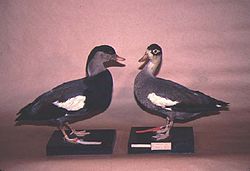 |
| Madagascar pochard | Aythya innotata | 30-50[21] | CR[21] |  [21] [21] | Rediscovered in 2006. Best estimate of current mature individuals is 45.[21] |  |
| Brazilian merganser | Mergus octosetaceus | 50-249[22] | CR[22] |  [22] [22] | This is a precautionary estimate. Actual population may exceed this estimate.[22] |  |
| White-winged duck |
Asarcornis scutulata |
150-450[23] | CR[23] |
 [23] [23] |
|
 |
| Baer's pochard | Aythya baeri | 150-700[24] | CR[24] |  [24] [24] | |  |
| Laysan duck | Anas laysanensis | 500-680[25] | CR[25] |  [25] [25] | The U.S. Fish & Wildlife Service estimated in 2022 that total population contains 1413 individuals between populations on Laysan, Midway, and Kure.[26] |

|
| Campbell teal | Anas nesiotis | > c. 500[27] | VU[27] |  [27] [27] | No formal count has been conducted. This is an opportunistic estimate.[27] | 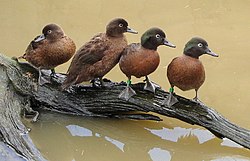 |
| Madagascar teal
(Bernier's teal) |
Anas bernieri | 630-1,900[28] | EN[28] |  [28] [28] | Total population is not given. This estimate for mature individuals is based on multiple counts.[28] |  |
| Hawaiian duck | Anas wyvilliana | 700-999[29] | VU[29] |  [29] [29] | Total population estimated at 751-1,185 individuals.[29] |  |
| Auckland teal | Anas aucklandica | 330-1,700
1,000-1,700[30] |
NT[30] |  [30] [30] | First given estimate is obtained from considering multiple counts over the years. The second is purely the 2021 estimate.[30] | 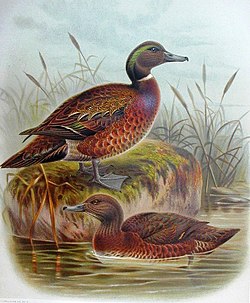 |
| Andaman teal |
Anas albogularis |
1,000-2,500[31] | NT[31] |
 [31] [31] |
Estimate is for mature individuals only; numbers may be higher.[31] |
 |
| Meller's duck | Anas melleri | 1,300-3,300[32] | EN[32] |  [32] [32] | Total population estimated at 2,000-5,000 individuals.[32] |  |
| Blue duck | Hymenolaimus malacorhynchos | 1,500-2,499[33] | EN[33] |  [33] [33] | |  |
| Brown teal | Anas chlorotis | 1,600-2,200[34] | NT[34] |  [34] [34] | Total population estimated at 2,400-3,400 individuals.[34] | 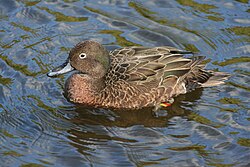 |
| Hawaiian goose
(Nēnē) |
Branta sandvicensis | 1,700-2,200[35] | NT[35] |  [35] [35] | |  |
| Scaly-sided merganser | Mergus squamatus | 2,000-3,500[36] | EN[36] |  [36] [36] | | 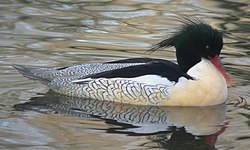 |
| Spectacled duck
(Bronze-winged teal) |
Speculanas specularis | 2,500-9,999[37] | NT[37] |  [37] [37] | Population size has not been directly estimated. Number of mature individuals likely toward lower end of estimate.[37] | 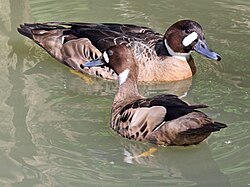 |
| Blue-winged goose | Cyanochen cyanoptera | 3,000-7,000[38] | NT[38] |  [38] [38] | |  |
| White-headed steamerduck
(Chubut steamer duck) |
Tachyeres leucocephalus | 3,400-3,700[39] | VU[39] |  [39] [39] | Total population estimated at 5,300-5,600 individuals from a count in 2011.[39] |  |
| Maccoa duck | Oxyura maccoa | 4,800-5,700[40] | EN[40] |  [40] [40] | Estimate from observations in East and South Africa.[40] |  |
| White-headed duck | Oxyura leucocephala | 5,300-8,700[41] | EN[41] |  [41] [41] | Total population estimated at 7,900-20,000 individuals based on separate metrics. A large portion of the population (central Asia) is likely not recorded.[41] | 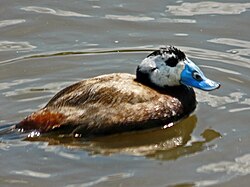 |
| West Indian whistling-duck | Dendrocygna arborea | 6,000-15,000[42] | NT[42] |  [42] [42] | Total population conservatively estimated at 10,000-19,999 individuals.[42] |  |
| Spotted whistling-duck | Dendrocygna guttata | 6,700-17,000[43] | LC[43] |  [43] [43] | Total population estimated at 10,000-25,000 individuals.[43] |  |
| Magellanic steamerduck
(Flightless steamer duck; Fuegian steamer duck) |
Tachyeres pteneres |
6,700-67,000[44] | LC[44] |
 [44] [44] |
There is little to no evidence of any declines in population, so assumed to be stable. There is no total population estimate.[44] |

|
| Coscoroba swan | Coscoroba coscoroba | 7,000-19,999[45] | LC[45] |  [45] [45] | Total population estimated at 10,000-25,000 individuals.[45] |  |
| Freckled duck | Stictonetta naevosa | 7,300-17,000[46] | LC[46] |  [46] [46] | Total population estimated at 11,000-26,000 individuals.[46] | 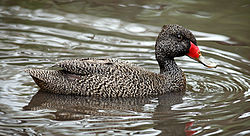 |
| Flying steamerduck |
Tachyeres patachonicus |
7,300-18,000[47] | LC[47] |
 [47] [47] |
Global population is estimated at 11,000-26,000 individuals. Falkland Islands population is estimated at 600–1,200 total birds.[47] |
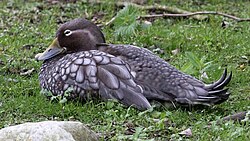 |
| White-backed duck | Thalassornis leuconotus | 8,500-20,000[48] | LC[48] |  [48] [48] | Total population estimated at 13,000-30,000 individuals.[48] | 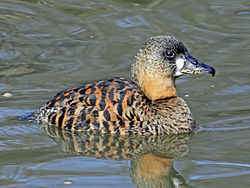 |
| Salvadori's teal | Salvadorina waigiuensis | >10,000[49] | LC[49] | ?[49] | Population size has not been quantified. Estimate given is based on extremely rough estimates for LC classification.[49] | 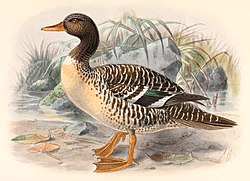 |
| Marbled duck | Marmaronetta angustirostris | 10,000-42,000[50] | NT[50] |  [50] [50] | Total population is estimated at 15,000-61,250 individuals. Species counts come from four discrete flyways, some of which are outdated.[50] |  |
| Sunda teal |
Anas gibberifrons |
10,000-100,000[51] |
LC[51] |
?[51] |
Total population is unknown.[51] |
 |
| Cape Barren goose | Cereopsis novaehollandiae | 11,000-12,000[52] | LC[52] |  [52] [52] | Total population estimated at 16,000-18,000 individuals.[52] |  |
| Blue-billed duck | Oxyura australis | 11,000-19,000[53] | LC[53] |  [53] [53] | Best estimate for number of mature individuals is 15,000.[53] | 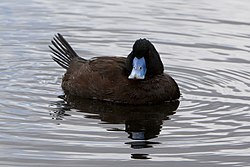 |
| Torrent duck |
Merganetta armata |
13,300-23,500[54] | LC[54] |
 [54] [54] |
Total population estimated to be 20,000-35,200 individuals.[54] |
 |
| Cape shoveler |
Spatula smithii |
13,300-33,300[55] | LC[55] |
 [55] [55] |
Total population estimated to be 20,000-50,000 individuals.[55] |
 |
| Philippine duck | Anas luzonica | 15,000-30,000[56] | LC[56] |  [56] [56] | Total population is estimated to fall between 20,000 and 40,000 from post-2020 censuses.[56] | 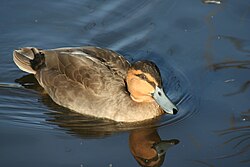 |
| Orinoco goose | Neochen jubata | 15,000-40,000[57] | LC[57] |  [57] [57] | |  |
| Lesser white-fronted goose | Anser erythropus | 16,000-27,000[58] | VU[58] |  [58] [58] | Global population estimated to be 24,000-40,000 individuals.[58] Current European breeding population estimated ~420 birds.[59] |  |
| Masked duck | Nomonyx dominicus | 16,000-200,000[60] | LC[60] |  [60] [60] | These are extreme estimates due to uncertainty on population.[60] | 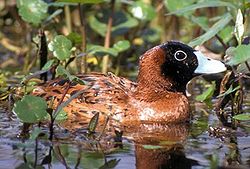 |
| Comb duck |
Sarkidiornis sylvicola |
16,700-66,700[61] | LC[61] |
 [61] [61] |
Total population estimated to be 25,000-100,000 individuals.[61] |
 |
| Horned screamer |
Anhima cornuta |
16,700-66,700[62] |
LC[62] |
 [62] [62] |
Total population estimated to be 25,000-100,000 individuals.[62] |
 |
| Hartlaub's duck | Pteronetta hartlaubii | 16,700-73,300[63] | LC[63] |  [63] [63] | Total population estimated to be 25,001-110,000 individuals.[63] |  |
| Red-breasted goose | Branta ruficollis | 19,000-48,000[64] | VU[64] |  [64] [64] | Best estimate for breeding population is 33,000. Total population estimated to be 28,100-72,600.[64][65] |  |
| Andean teal | Anas andium | 20,000-30,000[66] | LC[66] |  [66] [66] | Total population estimated to be <40,000 individuals.[66] |  |
| Musk duck |
Biziura lobata |
20,000-49,999[67] | LC[67] |
 [67] [67] |
Total population estimated to be 10,000-60,000 individuals.[67] |
 |
| Southern pochard |
Netta erythrophthalma |
20,000-65,000[68] |
LC[68] |
 [68] [68] |
Total population estimated to be 30,002-97,500 individuals.[68] |
 |
| New Zealand scaup | Aythya novaeseelandiae | 20,000-100,000[69] | LC[69] |  [69] [69] | |  |
| Andean duck |
Oxyura ferruginea |
23,300-73,300[70] | LC[70] |
 [70] [70] |
Total population is estimated to be 35,000-110,000 individuals.[70] |
 |
| Lake duck |
Oxyura vittata |
25,000-100,000[71] | LC[71] |
 [71] [71] |
Values given are total estimated population size.[71] |
 |
| Ringed teal |
Callonetta leucophrys |
25,000-100,000[72] | LC[72] |
 [72] [72] |
Values given are total estimated population size.[72] |
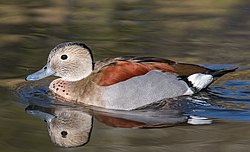 |
| Crested duck |
Lophonetta specularioides |
27,300-107,000[73] |
LC[73] |
 [73] [73] |
Total population is estimated to be 41,000-161,000 individuals.[73] |
 |
| Ruddy-headed goose | Chloephaga rubidiceps | 28,500-54,700[74] | LC[74] |  [74] [74] | Total population is estimated to be 42,744-82,000 individuals.[74] |  |
| Southern pintail
(Eaton's pintail) |
Anas eatoni | 30,000-40,000[75] | LC[75] |  [75] [75] | Total population is estimated at 45,000-60,000 in Kergeulen Islands; additional 1,800-2,100 in Crozet Islands.[75] |  |
| Green pygmy-goose |
Nettapus pulchellus |
33,300-133,000[76] |
LC[76] |
?[76] |
Total population is estimated to be 50,000-200,000 individuals.[76] |
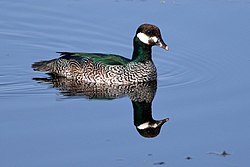 |
| Silver teal |
Spatula versicolor |
34,900-136,000[77] |
LC[77] |
 [77] [77] |
Total population is estimated to be 52,400-204,500 individuals.[77] |
 |
| Swan goose | Anser cygnoides | 36,000-43,500[78] | EN[78] |  [78] [78] | Total population is estimated to be 54,400 individuals.[78] |  |
| Blue-billed teal |
Spatula hottentota |
36,700-141,000[79] |
LC[79] |
 [79] [79] |
Total population is estimated to be 55,100-211,000 individuals.[79] |
 |
| African pygmy-goose |
Nettapus auritus |
38,300-213,000[80] |
LC[80] |
 [80] [80] |
Total population is estimated to be 57,500-320,000 individuals.[80] |
 |
| Trumpeter swan |
Cygnus buccinator |
50,000[81] | LC[81] |
 [81] [81] |
Total population is estimated at 76,000 individuals.[81] |

|
| Muscovy duck | Cairina moschata | 50,000-499,999[82] | LC[82] |  [82] [82] | Values given are total estimated population size.[82] |  |
| Smew | Mergellus albellus | 58,700-144,000[83] | LC[83] | ?[83] | Total population is estimated to be 88,000-216,000 individuals.[83] |  |
| Northern screamer | Chauna chavaria | 60,000-130,000[84] | LC[84] |  [84] [84] | Total population estimated at 100,000-200,000 individuals.[84] |
 |
| Knob-billed duck |
Sarkidiornis melanotos |
60,000-227,000[85] |
LC[85] |
 [85] [85] |
Total population is estimated at 90,000-340,000 individuals.[85] |
 |
| Mandarin duck | Aix galericulata | 65,000-66,000[86] | LC[86] |  [86] [86] | Values given are total estimated population size. Estimate is collated from four national populations.[86] |  |
| Southern screamer |
Chauna torquata |
66,700-667,000[87] |
LC[87] |
 [87] [87] |
Total population estimated to be 100,000-1,000,000 individuals.[87] |
 |
| Puna teal |
Spatula puna |
66,700-667,000[88] |
LC[88] |
 [88] [88] |
Total population estimated to be 100,000-1,000,000 individuals.[88] |
 |
| Plumed whistling-duck |
Dendrocygna eytoni |
66,700-667,000[89] |
LC[89] |
 [89] [89] |
Total population estimated to be 100,000-1,000,000 individuals.[89] |
 |
| Hardhead |
Aythya australis |
66,700-667,000[90] |
LC[90] |
 [90] [90] |
Total population estimated to be 100,001-1,001,000 individuals.[90] |
 |
| Yellow-billed pintail |
Anas georgica |
67,900-675,000[91] |
LC[91] |  [91] [91] |
Total population is estimated to be 101,801-1,013,000 individuals.[91] |
 |
| Chestnut teal |
Anas castanea |
70,000[92] |
LC[92] | ?[92] |
Total population is estimated to be 105,000 individuals.[92] |
 |
| Indian spot-billed duck |
Anas poecilorhyncha |
73,300-133,000[93] | LC[93] |
?[93] |
Total population is estimated to be 110,000-200,000 individuals.[93] |

|
| Cotton pygmy-goose | Nettapus coromandelianus | 83,300-741,000[94] | LC[94] | ?[94] | Total population is estimated to be 125,002-1,111,000 individuals.[94] |  |
| Falcated duck | Mareca falcata | 87,000-100,000[95] | LC[95] |  [95] [95] | Total population is estimated to be 132,500-150,000 individuals.[95] |  |
| Emperor goose | Anser canagicus | 90,000-120,000[96] | LC[96] |  [96] [96] | Total population is estimated to be 158,000 individuals.[96] |  |
| Whooper swan | Cygnus cygnus | 100,000-499,999[97] | LC[97] |  [97] [97] | Best estimate for number of mature individuals is 176,000.
Total population is estimated to be 264,600 individuals.[97] |
 |
| Pink-footed goose |
Anser brachyrhynchus |
100,000-499,999[98] | LC[98] |
 [98] [98] |
Best estimate for number of mature individuals is 387,000.
Total population is estimated to be 580,000 individuals.[98] |

|
| Black swan | Cygnus atratus | 100,000-1,000,000[99] | LC[99] |  [99] [99] | Values given are total estimated population size.[99] | 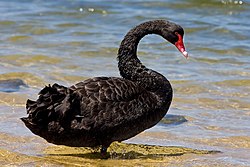 |
| Pacific black duck | Anas superciliosa | 120,000-783,000[100] | LC[100] |  [100] [100] | Total population is estimated to be 180,001-1,175,000 individuals.[100] |  |
| Steller's eider |
Polysticta stelleri |
130,000-150,000[101] | VU[101] |
 [101] [101] |
Values given are total estimated population size.[101] |
 |
| Lesser whistling-duck | Dendrocygna javanica | 133,000-1,330,000[102] | LC[102] |  [102] [102] | Total population is estimated to be 200,000-2,000,000 individuals.[102] |  |
| Ruddy shelduck | Tadorna ferruginea | 134,000-198,000[103] | LC[103] |  [103] [103] | Total population is estimated to be 201,030-297,080 individuals.[103] |  |
| Velvet scoter | Melanitta fusca | 141,000-268,000[104] | VU[104] |  [104] [104] | Total population is estimated to be 210,000-400,000 individuals.[104] |
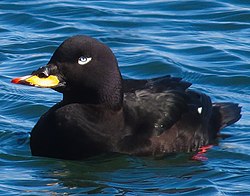
|
| Grey teal | Anas gracilis | 147,000-747,000[105] | LC[105] |  [105] [105] | Total population estimated to be 220,000-1,120,001 individuals.[105] |  |
| Barrow's goldeneye |
Bucephala islandica |
175,000-200,000[106] | LC[106] |
 [106] [106] |
Total population is estimated to be 260,000-300,000 individuals, though this is a rough estimate due to counting methods for populations in Alaska.[106]
European population (1600-1800 mature individuals) is Near Threatened.[107] |
 |
| Ferruginous duck |
Aythya nyroca |
180,000-240,000[108] | NT[108] |
 [108] [108] |
Values given are total estimated population size.[108] |
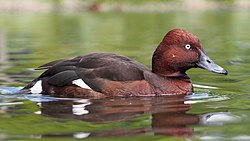 |
| Harlequin duck | Histrionicus histrionicus | 190,000-380,000[109] | LC[109] |  [109] [109] | Values given are total estimated population size.[109] |  |
| Spur-winged Goose |
Plectropterus gambensis |
200,000-333,000[110] |
LC[110] |
 [110] [110] |
Total population is estimated to be 300,000-500,000 individuals.[110] |
 |
| Black-bellied whistling-duck | Dendrocygna autumnalis | 200,000-2,000,000[111] | LC[111] |  [111] [111] | IUCN does not provide a total population estimate.[111] Partners in Flight estimates breeding population at 1,000,000 individuals.[112] |  |
| Tundra swan | Cygnus columbianus | 221,000-234,000[113] | LC[113] |  [113] [113] | Total population is estimated to be 332,000-352,000 individuals.[113]European population classified as Vulnerable.[114] |
 |
| Spectacled eider | Somateria fischeri | 250,000[115] | NT[115] |  [115] [115] | Total population is estimated to be 360,000-400,000 individuals.[115] | 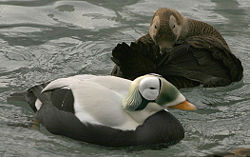 |
| Surf scoter | Melanitta perspicillata | 250,000-1,300,000[116] | LC[116] |  [116] [116] | Values given are total estimated population size.[116] | 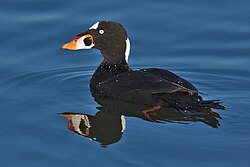 |
| Red-crested pochard |
Netta rufina |
300,000-440,000[117] | LC[117] |
 [117] [117] |
Total population is estimated to be 450,000-660,000.[117] |
 |
| Mute swan | Cygnus olor | 308,000-348,000[118] | LC[118] |  [118] [118] | Total population (including introduced range) is estimated to be 461,300-522,400 individuals.[118] |  |
| Baikal teal |
Sibirionetta formosa |
333,000-467,000[119] |
LC[119] |
 [119] [119] |
Total population is estimated to be 500,000-700,000 individuals.[119] |
 |
| Black scoter | Melanitta americana | 350,000-560,000[120] | NT[120] |  [120] [120] | Total population is estimated to be 350,000-560,000 individuals.[120] |  |
| Cinnamon teal |
Spatula cyanoptera |
380,000[121] | LC[121] |
 [121] [121] |
IUCN does not provide a total population estimate.[121] |
 |
| White-winged scoter | Melanitta deglandi | 400,000[112] | LC[122] |  [122] [122] | IUCN does not provide population estimates for this bird.[122]
Values given come from Partners in Flight estimate. |
 |
| Siberian scoter
(Stejneger's scoter) |
Melanitta stenjnegeri |
400,000-700,000[123] | LC[123] |
 [123] [123] |
Total population is estimated to be 600,000-1,000,000 individuals.[123] |
 |
| Common shelduck | Tadorna tadorna | 415,000-500,000[124] | LC[124] |  [124] [124] | Total population is estimated to be 625,000-750,000 individuals.[124] | 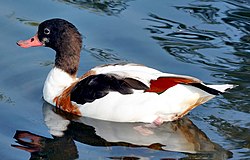 |
| Brent goose
(Brant) |
Branta bernicla | 490,000[125] | LC[125] | ?[125] | IUCN does not provide a total population estimate. European population is 3,000-3,600 mature individuals.[125] |  |
| Red-breasted merganser | Mergus serrator | 495,000-605,000[126] | LC[126] |  [126] [126] | Values given are total estimated population size.[126] European breeding populations are classified as Near Threatened.[127] | 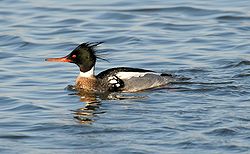 |
| Magpie goose | Anseranas semipalmata | 667,000[128] | LC[128] |  [128] [128] | Total population estimated to be 1,000,000 individuals.[128] |  |
| Rosy-billed pochard | Netta peposaca | 667,000[129] | LC[129] |  [129] [129] | Total population estimated to be 1,000,000 individuals.[129] |  |
| Bean goose |
Anser fabalis |
680,000-800,000[130] | LC[130] |
 [130] [130] |
Values given are estimated total population size.[130]
Note that the IOU split this species into the separate Taiga bean goose and Tundra bean goose.[1] This split has not been recognized by the IUCN. |
 |
| Canvasback |
Aythya valisineria |
690,000[131] | LC[131] |
 [131] [131] |
No total population estimate given.[131] |
 |
| American black duck |
Anas rubripes |
700,000[132] | LC[132] |
 [132] [132] |
No total population estimate given.[132] |
 |
| Common pochard | Aythya ferina | 760,000-790,000[133] | VU[133] |  [133] [133] | Total population estimated to be 1.14-1.18 million individuals.[133] | 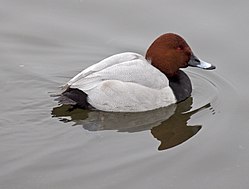 |
| King eider | Somateria spectabilis | 800,000-900,000[134] | LC[134] |  [134] [134] | Values given are estimated total population size.[134] |  |
| Eastern spot-billed duck | Anas zonorhyncha | 800,000-1,600,000[135] | LC[135] |  [135] [135] | Values given are estimated total population size.[135] | 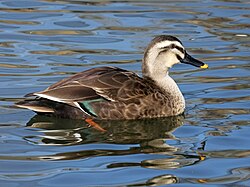 |
| Fulvous whistling-duck | Dendrocygna bicolor | 820,000-980,000[136] | LC[136] |  [136] [136] | Total population estimated to be 1.23-1.47 million individuals.[136] |  |
| Barnacle goose |
Branta leucopsis |
880,000[137] | LC[137] |
 [137] [137] |
Values given are estimated total population size.[137] |
 |
| Greylag goose | Anser anser | 1,000,000-1,100,000[138] | LC[138] |  [138] [138] | Values given are estimated total population size.[138] |  |
| Garganey | Spatula querquedula | 1,030,000-1,700,000[139] | LC[139] |  [139] [139] | Total population estimated to be 1.55-2.55 million individuals.[139] | 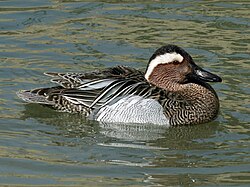 |
| Common scoter | Melanitta nigra | 1,070,000[140] | LC[140] | ?[140] | Total population estimated to be 1.6 million individuals.[140] | 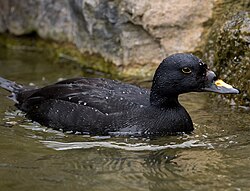 |
| Hooded merganser |
Lophodytes cucullatus |
1,100,000[141] | LC[141] |
 [141] [141] |
Values given are estimated total poplation size.[141] |
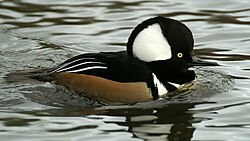 |
| Redhead |
Aythya americana |
1,200,000[142] | LC[142] |
 [142] [142] |
No total population estimate given.[142] |
 |
| Bufflehead | Bucephala albeola | 1,300,000[143] | LC[143] |  [143] [143] | No total population estimate given.[143] |  |
| Tufted duck | Aythya fuligula | 1,330,000-1,730,000[144] | LC[144] |  [144] [144] | Total population estimated to be 2.0-2.6 million individuals.[144] |  |
| White-faced whistling-duck | Dendrocygna viduata | 1,410,000-1,700,000[145] | LC[145] |  [145] [145] | Total population estimated to be 2.12-2.55 million individuals.[145] |  |
| Common eider | Somateria mollissima | 1,580,000-1,910,000[146] | NT[146] | ?[146] | Total population estimated to be 3.3-4.0 million individuals.[146] | 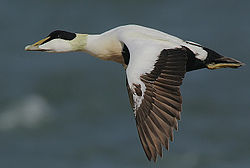 |
| Goosander
(Common merganser) |
Mergus merganser | 1,700,000-2,400,000[147] | LC[147] | ?[147] | Values given are estimated total population size.[147] |  |
| Eurasian wigeon | Mareca penelope | 1,770,000-2,390,000[148] | LC[148] |  [148] [148] | Total population estimated to be 2.65-3.59 million individuals.[148] |  |
| Ring-necked duck |
Aythya collaris |
2,000,000[149] | LC[149] |
 [149] [149] |
No total population estimate given.[149] |
 |
| Ross's goose |
Anser rossii |
2,100,000[150] | LC[150] |
 [150] [150] |
No total population estimate given.[150] |
 |
| American wigeon |
Mareca americana |
2,700,000[151] | LC[151] |
 [151] [151] |
No total population estimate given.[151] |
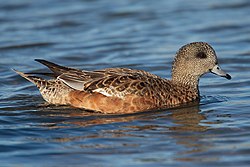 |
| Common goldeneye | Bucephala clangula | 2,700,000-4,700,000[152] | LC[152] |  [152] [152] | Values given are estimated total population size.[152] | 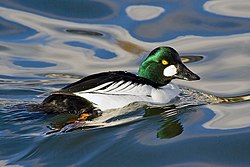 |
| Common teal |
Anas crecca |
2,800,000[153] | LC[153] |
?[153] |
No total population estimate given.[153] |
 |
| Long-tailed duck | Clangula hyemalis | 3,200-000-3,750,000[154] | VU[154] |  [154] [154] | Values given are estimated total population size.[154] |  |
| Lesser scaup |
Aythya affinis |
3,700,000[155] | LC[155] |
 [155] [155] |
No total population estimate given.[155] |
 |
| Green-winged teal |
Anas carolinensis |
3,900,000[156] | LC[156] |
 [156] [156] |
No total population estimate given.[156] |
 |
| Gadwall | Mareca strepera | 4,050,000-4,860,000[157] | LC[157] |  [157] [157] | No total population estimate given.[157] |  |
| Northern shoveler | Anas clypeata | 4,300,000-4,700,000[158] | LC[158] |  [158] [158] | Total population estimated to be 6.5-7.0 million individuals.[158] |  |
| Cackling goose | Branta hutchinsii | 4,500,000[159] | LC[159] |  [159] [159] | No total population estimate given.[159] |  |
| Wood duck |
Aix sponsa |
4,600,000[160] | LC[160] |
 [160] [160] |
No total population estimate given.[160] |
 |
| Northern pintail | Anas acuta | 4,700,000-4,800,000[161] | LC[161] |  [161] [161] | Total population estimated to be 7.1-7.2 million individuals.[161] | 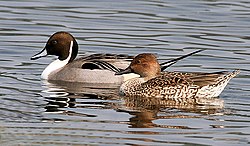 |
| Greater scaup | Aythya marila | 4,920,000-5,130,000[162] | LC[162] |  [162] [162] | Values given are estimated total population size.[162] |  |
| Greater white-fronted goose |
Anser albifrons |
5,000,000-5,999,999[163] | LC[163] |
?[163] |
No total population estimate given.[163] |
 |
| Canada goose |
Branta canadensis |
5,000,000-6,200,000[164] | LC[164] |
 [164] [164] |
Values given are estimated total population size.[164] Note that current data from Partners in Flight estimate 7.1 million mature individuals alone.[112] |
 |
| Blue-winged teal |
Spatula discors |
7,800,000[165] | LC[165] |
 [165] [165] |
No total population estimate given.[165] |
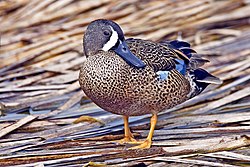 |
| Snow goose |
Anser caerulescens |
15,000,000[166] | LC[166] |
 [166] [166] |
No total population estimate given.[166] |
 |
| Mallard | Anas platyrhynchos | 17,260,000-19,300,000[167] | LC[167] |  [167] [167] | Total population estimated to be 26.15-29.24 million individuals.[167] | 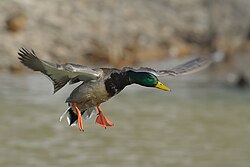 |
|














































































































































